Adidas Marketing Plan for Entering the Netherlands Market
VerifiedAdded on 2023/05/27
|16
|4501
|109
AI Summary
This marketing plan outlines Adidas' strategy for entering the Netherlands market, including their marketing objectives, market analysis, competitor analysis, target market, and marketing mix. The plan includes a detailed analysis of the sports industry in the Netherlands, as well as the company's competitors and target consumers.
Contribute Materials
Your contribution can guide someone’s learning journey. Share your
documents today.
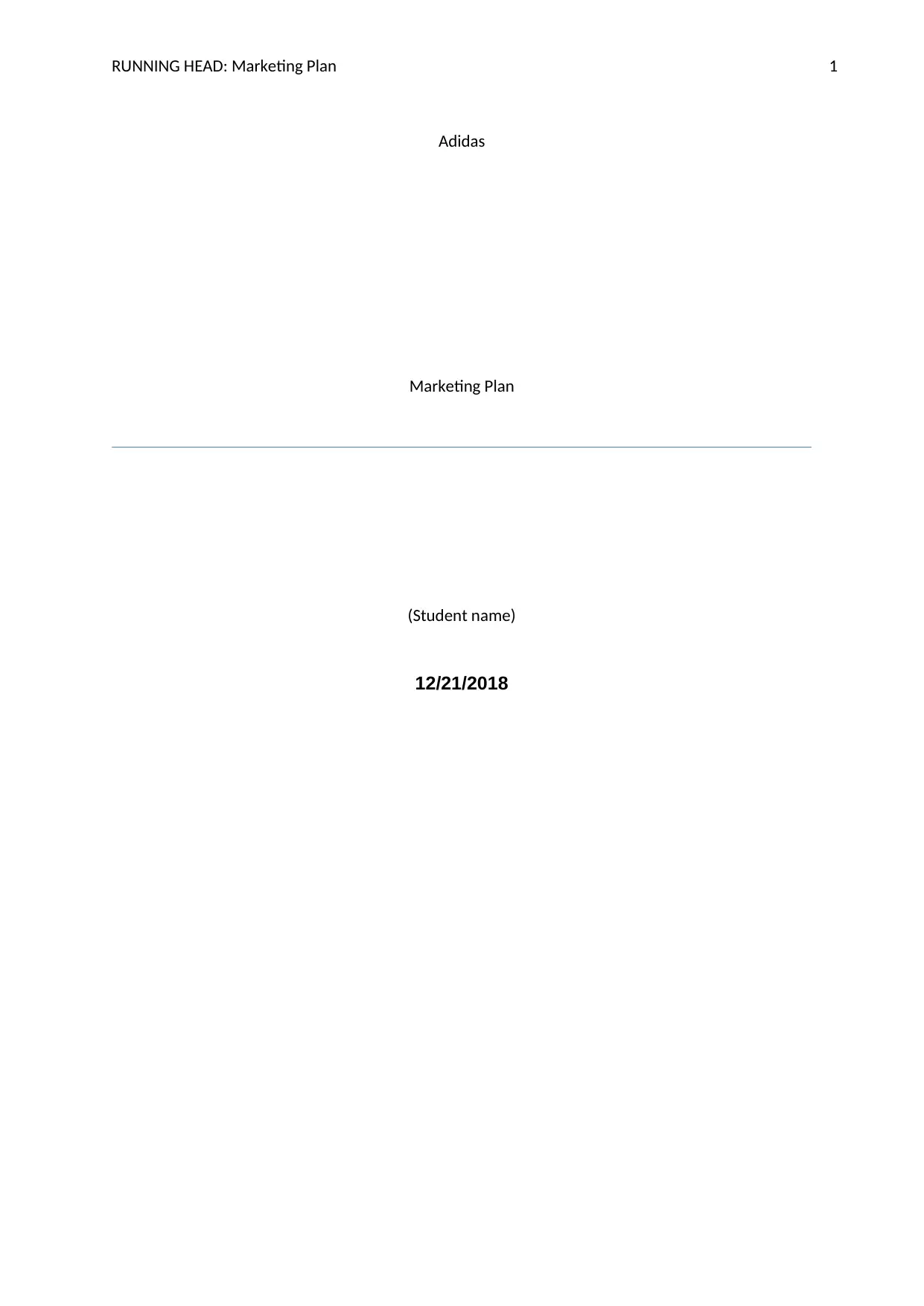
RUNNING HEAD: Marketing Plan 1
Adidas
Marketing Plan
(Student name)
12/21/2018
Adidas
Marketing Plan
(Student name)
12/21/2018
Secure Best Marks with AI Grader
Need help grading? Try our AI Grader for instant feedback on your assignments.
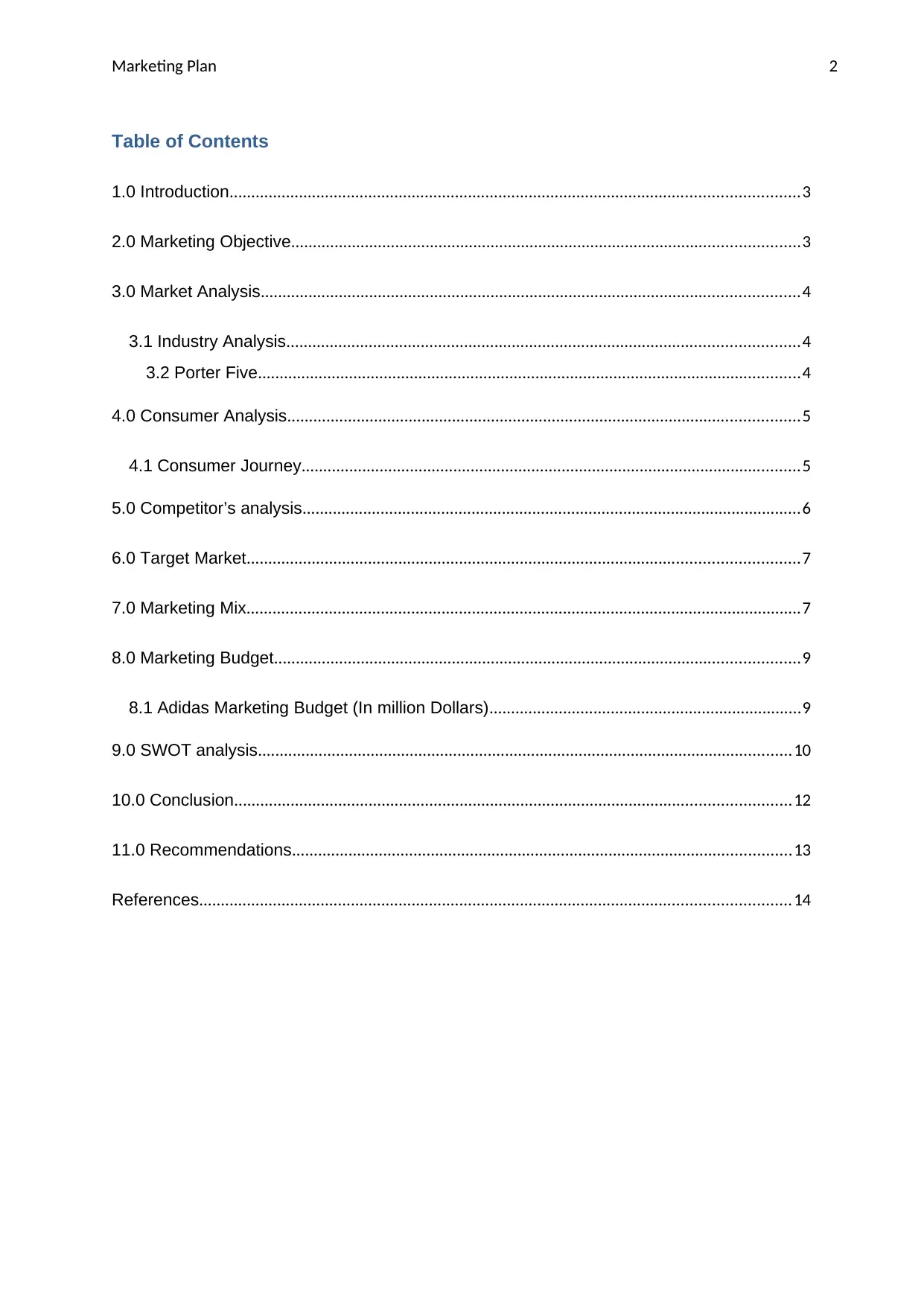
Marketing Plan 2
Table of Contents
1.0 Introduction...................................................................................................................................3
2.0 Marketing Objective.....................................................................................................................3
3.0 Market Analysis............................................................................................................................4
3.1 Industry Analysis......................................................................................................................4
3.2 Porter Five.............................................................................................................................4
4.0 Consumer Analysis......................................................................................................................5
4.1 Consumer Journey...................................................................................................................5
5.0 Competitor’s analysis...................................................................................................................6
6.0 Target Market...............................................................................................................................7
7.0 Marketing Mix................................................................................................................................7
8.0 Marketing Budget.........................................................................................................................9
8.1 Adidas Marketing Budget (In million Dollars)........................................................................9
9.0 SWOT analysis...........................................................................................................................10
10.0 Conclusion................................................................................................................................12
11.0 Recommendations...................................................................................................................13
References........................................................................................................................................14
Table of Contents
1.0 Introduction...................................................................................................................................3
2.0 Marketing Objective.....................................................................................................................3
3.0 Market Analysis............................................................................................................................4
3.1 Industry Analysis......................................................................................................................4
3.2 Porter Five.............................................................................................................................4
4.0 Consumer Analysis......................................................................................................................5
4.1 Consumer Journey...................................................................................................................5
5.0 Competitor’s analysis...................................................................................................................6
6.0 Target Market...............................................................................................................................7
7.0 Marketing Mix................................................................................................................................7
8.0 Marketing Budget.........................................................................................................................9
8.1 Adidas Marketing Budget (In million Dollars)........................................................................9
9.0 SWOT analysis...........................................................................................................................10
10.0 Conclusion................................................................................................................................12
11.0 Recommendations...................................................................................................................13
References........................................................................................................................................14
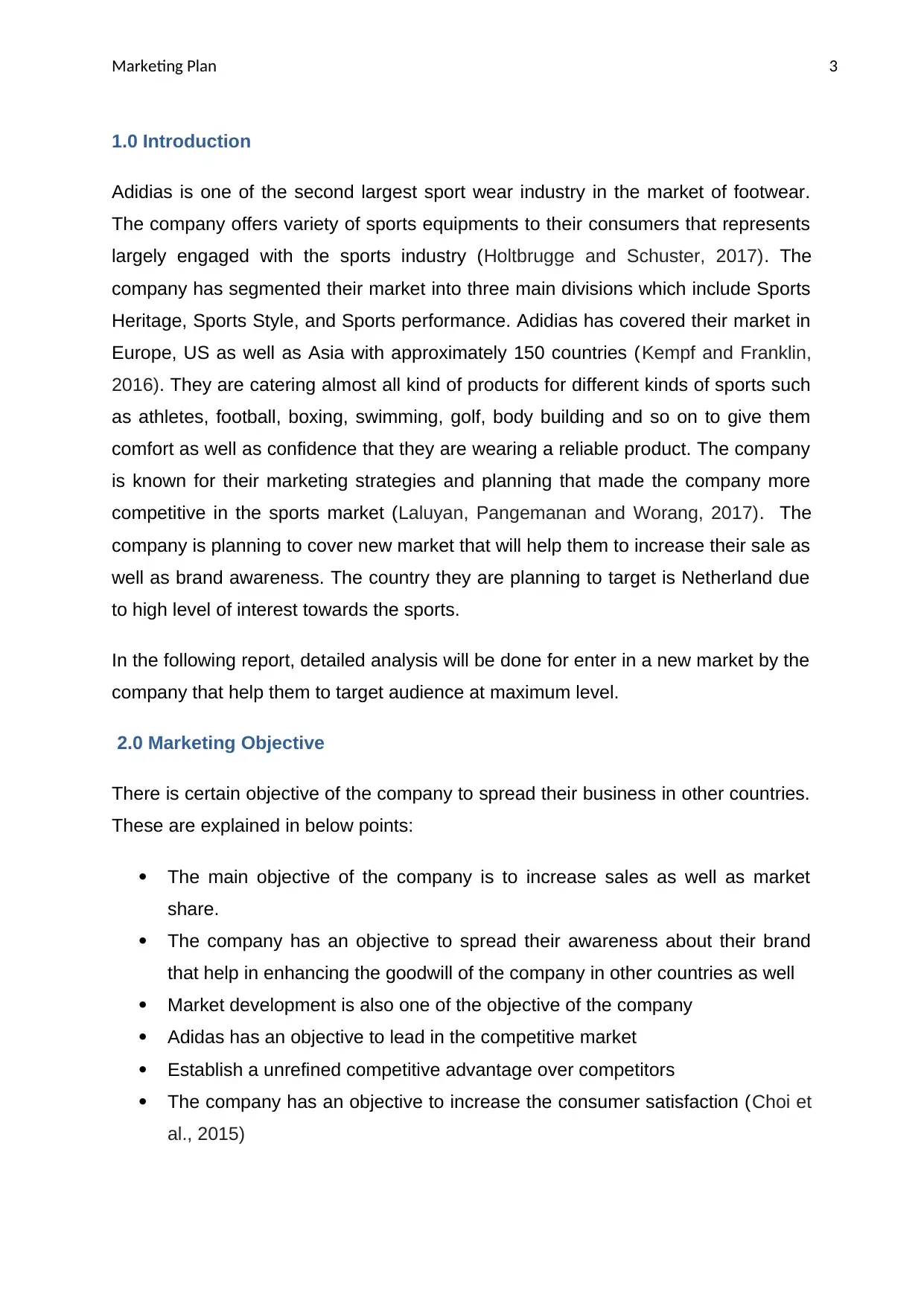
Marketing Plan 3
1.0 Introduction
Adidias is one of the second largest sport wear industry in the market of footwear.
The company offers variety of sports equipments to their consumers that represents
largely engaged with the sports industry (Holtbrugge and Schuster, 2017). The
company has segmented their market into three main divisions which include Sports
Heritage, Sports Style, and Sports performance. Adidias has covered their market in
Europe, US as well as Asia with approximately 150 countries (Kempf and Franklin,
2016). They are catering almost all kind of products for different kinds of sports such
as athletes, football, boxing, swimming, golf, body building and so on to give them
comfort as well as confidence that they are wearing a reliable product. The company
is known for their marketing strategies and planning that made the company more
competitive in the sports market (Laluyan, Pangemanan and Worang, 2017). The
company is planning to cover new market that will help them to increase their sale as
well as brand awareness. The country they are planning to target is Netherland due
to high level of interest towards the sports.
In the following report, detailed analysis will be done for enter in a new market by the
company that help them to target audience at maximum level.
2.0 Marketing Objective
There is certain objective of the company to spread their business in other countries.
These are explained in below points:
The main objective of the company is to increase sales as well as market
share.
The company has an objective to spread their awareness about their brand
that help in enhancing the goodwill of the company in other countries as well
Market development is also one of the objective of the company
Adidas has an objective to lead in the competitive market
Establish a unrefined competitive advantage over competitors
The company has an objective to increase the consumer satisfaction (Choi et
al., 2015)
1.0 Introduction
Adidias is one of the second largest sport wear industry in the market of footwear.
The company offers variety of sports equipments to their consumers that represents
largely engaged with the sports industry (Holtbrugge and Schuster, 2017). The
company has segmented their market into three main divisions which include Sports
Heritage, Sports Style, and Sports performance. Adidias has covered their market in
Europe, US as well as Asia with approximately 150 countries (Kempf and Franklin,
2016). They are catering almost all kind of products for different kinds of sports such
as athletes, football, boxing, swimming, golf, body building and so on to give them
comfort as well as confidence that they are wearing a reliable product. The company
is known for their marketing strategies and planning that made the company more
competitive in the sports market (Laluyan, Pangemanan and Worang, 2017). The
company is planning to cover new market that will help them to increase their sale as
well as brand awareness. The country they are planning to target is Netherland due
to high level of interest towards the sports.
In the following report, detailed analysis will be done for enter in a new market by the
company that help them to target audience at maximum level.
2.0 Marketing Objective
There is certain objective of the company to spread their business in other countries.
These are explained in below points:
The main objective of the company is to increase sales as well as market
share.
The company has an objective to spread their awareness about their brand
that help in enhancing the goodwill of the company in other countries as well
Market development is also one of the objective of the company
Adidas has an objective to lead in the competitive market
Establish a unrefined competitive advantage over competitors
The company has an objective to increase the consumer satisfaction (Choi et
al., 2015)
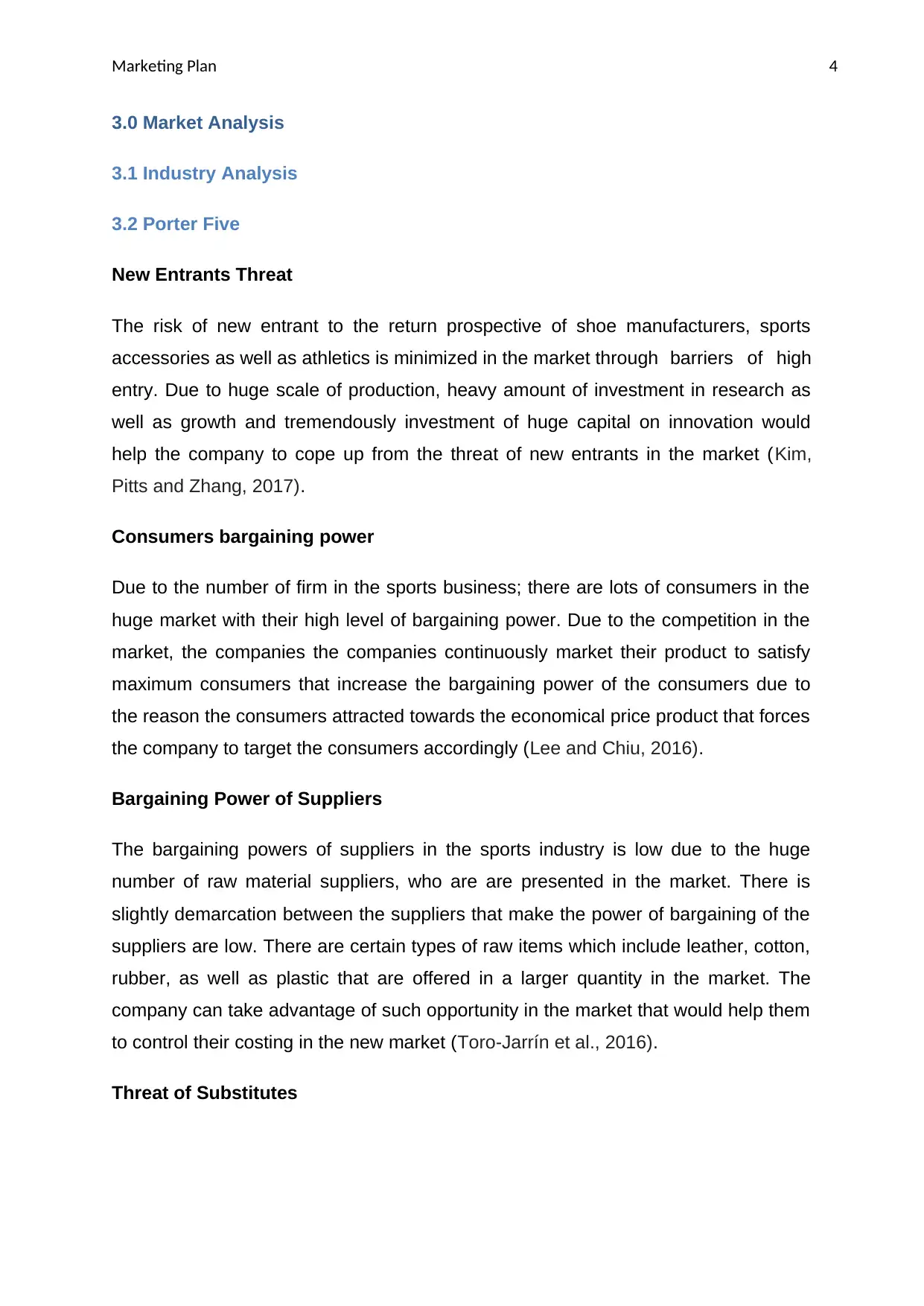
Marketing Plan 4
3.0 Market Analysis
3.1 Industry Analysis
3.2 Porter Five
New Entrants Threat
The risk of new entrant to the return prospective of shoe manufacturers, sports
accessories as well as athletics is minimized in the market through barriers of high
entry. Due to huge scale of production, heavy amount of investment in research as
well as growth and tremendously investment of huge capital on innovation would
help the company to cope up from the threat of new entrants in the market (Kim,
Pitts and Zhang, 2017).
Consumers bargaining power
Due to the number of firm in the sports business; there are lots of consumers in the
huge market with their high level of bargaining power. Due to the competition in the
market, the companies the companies continuously market their product to satisfy
maximum consumers that increase the bargaining power of the consumers due to
the reason the consumers attracted towards the economical price product that forces
the company to target the consumers accordingly (Lee and Chiu, 2016).
Bargaining Power of Suppliers
The bargaining powers of suppliers in the sports industry is low due to the huge
number of raw material suppliers, who are are presented in the market. There is
slightly demarcation between the suppliers that make the power of bargaining of the
suppliers are low. There are certain types of raw items which include leather, cotton,
rubber, as well as plastic that are offered in a larger quantity in the market. The
company can take advantage of such opportunity in the market that would help them
to control their costing in the new market (Toro-Jarrín et al., 2016).
Threat of Substitutes
3.0 Market Analysis
3.1 Industry Analysis
3.2 Porter Five
New Entrants Threat
The risk of new entrant to the return prospective of shoe manufacturers, sports
accessories as well as athletics is minimized in the market through barriers of high
entry. Due to huge scale of production, heavy amount of investment in research as
well as growth and tremendously investment of huge capital on innovation would
help the company to cope up from the threat of new entrants in the market (Kim,
Pitts and Zhang, 2017).
Consumers bargaining power
Due to the number of firm in the sports business; there are lots of consumers in the
huge market with their high level of bargaining power. Due to the competition in the
market, the companies the companies continuously market their product to satisfy
maximum consumers that increase the bargaining power of the consumers due to
the reason the consumers attracted towards the economical price product that forces
the company to target the consumers accordingly (Lee and Chiu, 2016).
Bargaining Power of Suppliers
The bargaining powers of suppliers in the sports industry is low due to the huge
number of raw material suppliers, who are are presented in the market. There is
slightly demarcation between the suppliers that make the power of bargaining of the
suppliers are low. There are certain types of raw items which include leather, cotton,
rubber, as well as plastic that are offered in a larger quantity in the market. The
company can take advantage of such opportunity in the market that would help them
to control their costing in the new market (Toro-Jarrín et al., 2016).
Threat of Substitutes
Secure Best Marks with AI Grader
Need help grading? Try our AI Grader for instant feedback on your assignments.
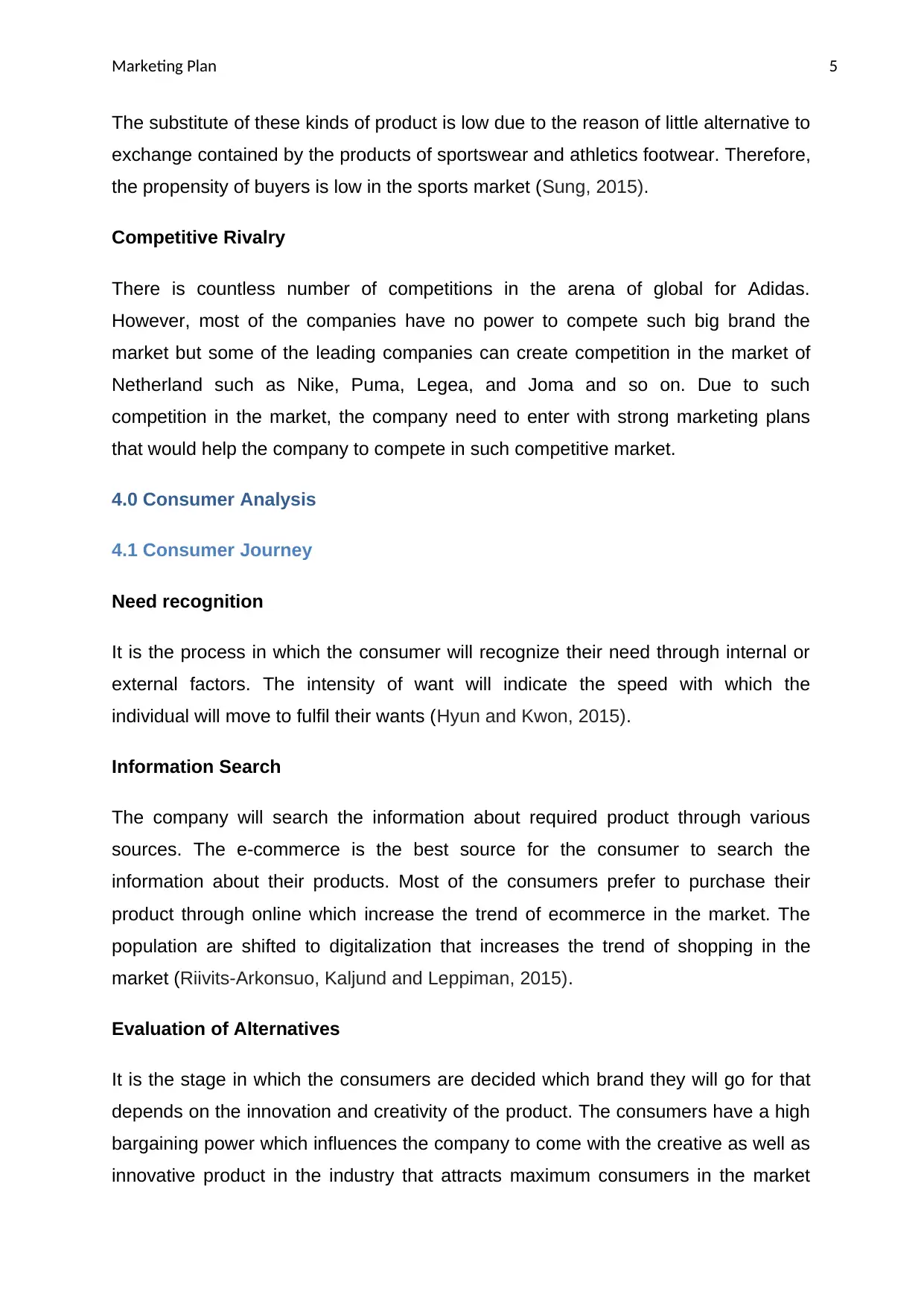
Marketing Plan 5
The substitute of these kinds of product is low due to the reason of little alternative to
exchange contained by the products of sportswear and athletics footwear. Therefore,
the propensity of buyers is low in the sports market (Sung, 2015).
Competitive Rivalry
There is countless number of competitions in the arena of global for Adidas.
However, most of the companies have no power to compete such big brand the
market but some of the leading companies can create competition in the market of
Netherland such as Nike, Puma, Legea, and Joma and so on. Due to such
competition in the market, the company need to enter with strong marketing plans
that would help the company to compete in such competitive market.
4.0 Consumer Analysis
4.1 Consumer Journey
Need recognition
It is the process in which the consumer will recognize their need through internal or
external factors. The intensity of want will indicate the speed with which the
individual will move to fulfil their wants (Hyun and Kwon, 2015).
Information Search
The company will search the information about required product through various
sources. The e-commerce is the best source for the consumer to search the
information about their products. Most of the consumers prefer to purchase their
product through online which increase the trend of ecommerce in the market. The
population are shifted to digitalization that increases the trend of shopping in the
market (Riivits-Arkonsuo, Kaljund and Leppiman, 2015).
Evaluation of Alternatives
It is the stage in which the consumers are decided which brand they will go for that
depends on the innovation and creativity of the product. The consumers have a high
bargaining power which influences the company to come with the creative as well as
innovative product in the industry that attracts maximum consumers in the market
The substitute of these kinds of product is low due to the reason of little alternative to
exchange contained by the products of sportswear and athletics footwear. Therefore,
the propensity of buyers is low in the sports market (Sung, 2015).
Competitive Rivalry
There is countless number of competitions in the arena of global for Adidas.
However, most of the companies have no power to compete such big brand the
market but some of the leading companies can create competition in the market of
Netherland such as Nike, Puma, Legea, and Joma and so on. Due to such
competition in the market, the company need to enter with strong marketing plans
that would help the company to compete in such competitive market.
4.0 Consumer Analysis
4.1 Consumer Journey
Need recognition
It is the process in which the consumer will recognize their need through internal or
external factors. The intensity of want will indicate the speed with which the
individual will move to fulfil their wants (Hyun and Kwon, 2015).
Information Search
The company will search the information about required product through various
sources. The e-commerce is the best source for the consumer to search the
information about their products. Most of the consumers prefer to purchase their
product through online which increase the trend of ecommerce in the market. The
population are shifted to digitalization that increases the trend of shopping in the
market (Riivits-Arkonsuo, Kaljund and Leppiman, 2015).
Evaluation of Alternatives
It is the stage in which the consumers are decided which brand they will go for that
depends on the innovation and creativity of the product. The consumers have a high
bargaining power which influences the company to come with the creative as well as
innovative product in the industry that attracts maximum consumers in the market
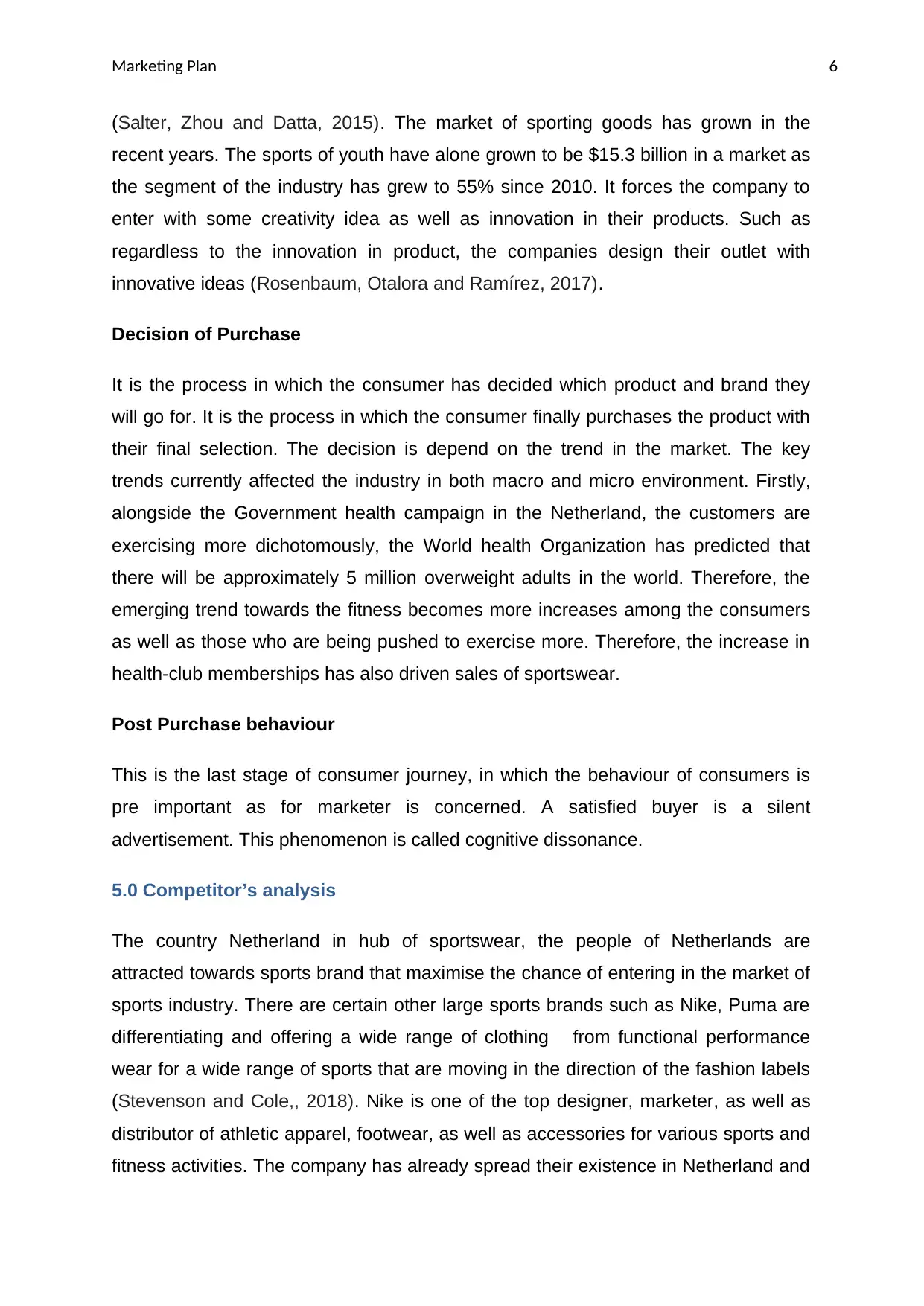
Marketing Plan 6
(Salter, Zhou and Datta, 2015). The market of sporting goods has grown in the
recent years. The sports of youth have alone grown to be $15.3 billion in a market as
the segment of the industry has grew to 55% since 2010. It forces the company to
enter with some creativity idea as well as innovation in their products. Such as
regardless to the innovation in product, the companies design their outlet with
innovative ideas (Rosenbaum, Otalora and Ramírez, 2017).
Decision of Purchase
It is the process in which the consumer has decided which product and brand they
will go for. It is the process in which the consumer finally purchases the product with
their final selection. The decision is depend on the trend in the market. The key
trends currently affected the industry in both macro and micro environment. Firstly,
alongside the Government health campaign in the Netherland, the customers are
exercising more dichotomously, the World health Organization has predicted that
there will be approximately 5 million overweight adults in the world. Therefore, the
emerging trend towards the fitness becomes more increases among the consumers
as well as those who are being pushed to exercise more. Therefore, the increase in
health-club memberships has also driven sales of sportswear.
Post Purchase behaviour
This is the last stage of consumer journey, in which the behaviour of consumers is
pre important as for marketer is concerned. A satisfied buyer is a silent
advertisement. This phenomenon is called cognitive dissonance.
5.0 Competitor’s analysis
The country Netherland in hub of sportswear, the people of Netherlands are
attracted towards sports brand that maximise the chance of entering in the market of
sports industry. There are certain other large sports brands such as Nike, Puma are
differentiating and offering a wide range of clothing from functional performance
wear for a wide range of sports that are moving in the direction of the fashion labels
(Stevenson and Cole,, 2018). Nike is one of the top designer, marketer, as well as
distributor of athletic apparel, footwear, as well as accessories for various sports and
fitness activities. The company has already spread their existence in Netherland and
(Salter, Zhou and Datta, 2015). The market of sporting goods has grown in the
recent years. The sports of youth have alone grown to be $15.3 billion in a market as
the segment of the industry has grew to 55% since 2010. It forces the company to
enter with some creativity idea as well as innovation in their products. Such as
regardless to the innovation in product, the companies design their outlet with
innovative ideas (Rosenbaum, Otalora and Ramírez, 2017).
Decision of Purchase
It is the process in which the consumer has decided which product and brand they
will go for. It is the process in which the consumer finally purchases the product with
their final selection. The decision is depend on the trend in the market. The key
trends currently affected the industry in both macro and micro environment. Firstly,
alongside the Government health campaign in the Netherland, the customers are
exercising more dichotomously, the World health Organization has predicted that
there will be approximately 5 million overweight adults in the world. Therefore, the
emerging trend towards the fitness becomes more increases among the consumers
as well as those who are being pushed to exercise more. Therefore, the increase in
health-club memberships has also driven sales of sportswear.
Post Purchase behaviour
This is the last stage of consumer journey, in which the behaviour of consumers is
pre important as for marketer is concerned. A satisfied buyer is a silent
advertisement. This phenomenon is called cognitive dissonance.
5.0 Competitor’s analysis
The country Netherland in hub of sportswear, the people of Netherlands are
attracted towards sports brand that maximise the chance of entering in the market of
sports industry. There are certain other large sports brands such as Nike, Puma are
differentiating and offering a wide range of clothing from functional performance
wear for a wide range of sports that are moving in the direction of the fashion labels
(Stevenson and Cole,, 2018). Nike is one of the top designer, marketer, as well as
distributor of athletic apparel, footwear, as well as accessories for various sports and
fitness activities. The company has already spread their existence in Netherland and
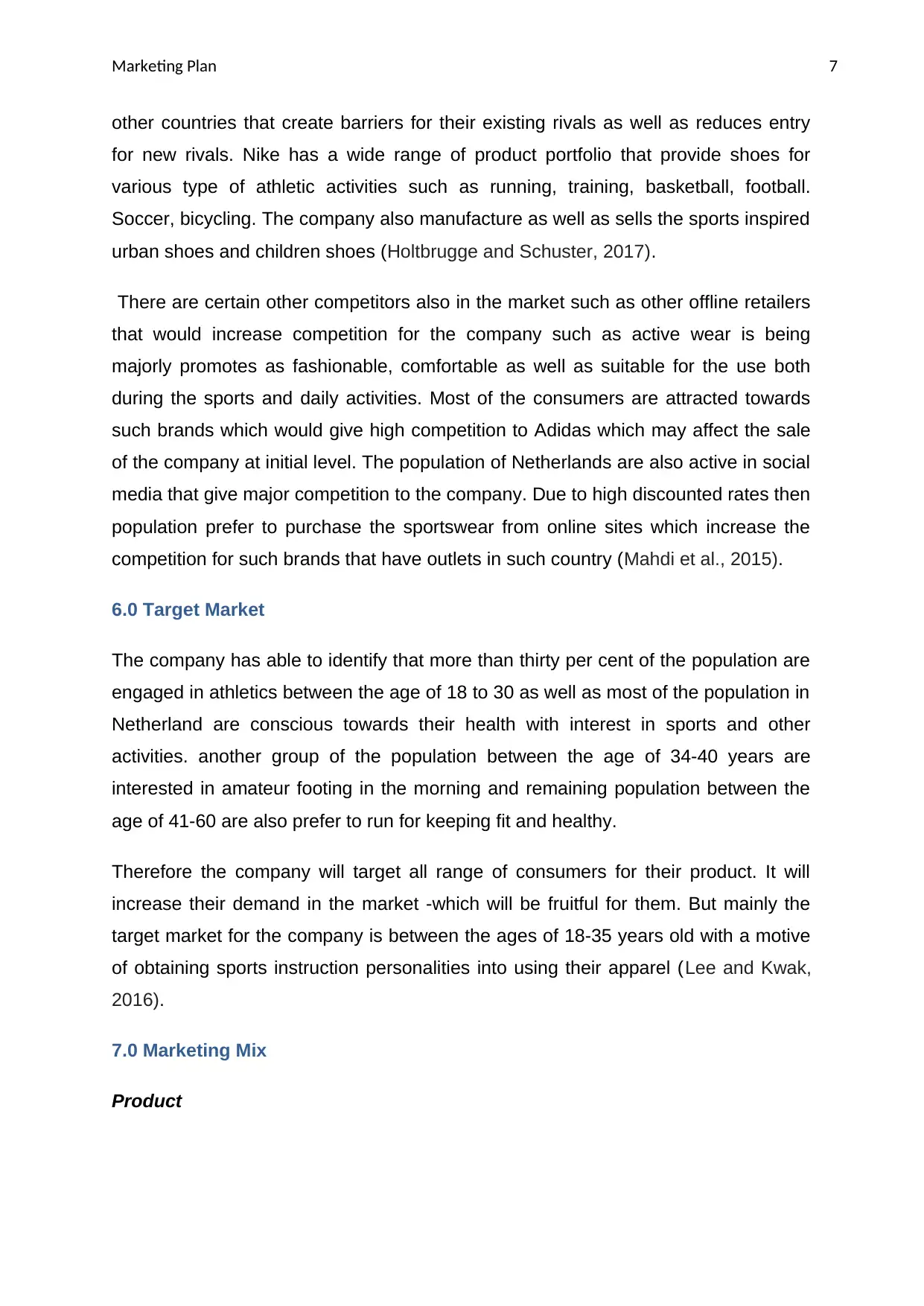
Marketing Plan 7
other countries that create barriers for their existing rivals as well as reduces entry
for new rivals. Nike has a wide range of product portfolio that provide shoes for
various type of athletic activities such as running, training, basketball, football.
Soccer, bicycling. The company also manufacture as well as sells the sports inspired
urban shoes and children shoes (Holtbrugge and Schuster, 2017).
There are certain other competitors also in the market such as other offline retailers
that would increase competition for the company such as active wear is being
majorly promotes as fashionable, comfortable as well as suitable for the use both
during the sports and daily activities. Most of the consumers are attracted towards
such brands which would give high competition to Adidas which may affect the sale
of the company at initial level. The population of Netherlands are also active in social
media that give major competition to the company. Due to high discounted rates then
population prefer to purchase the sportswear from online sites which increase the
competition for such brands that have outlets in such country (Mahdi et al., 2015).
6.0 Target Market
The company has able to identify that more than thirty per cent of the population are
engaged in athletics between the age of 18 to 30 as well as most of the population in
Netherland are conscious towards their health with interest in sports and other
activities. another group of the population between the age of 34-40 years are
interested in amateur footing in the morning and remaining population between the
age of 41-60 are also prefer to run for keeping fit and healthy.
Therefore the company will target all range of consumers for their product. It will
increase their demand in the market -which will be fruitful for them. But mainly the
target market for the company is between the ages of 18-35 years old with a motive
of obtaining sports instruction personalities into using their apparel (Lee and Kwak,
2016).
7.0 Marketing Mix
Product
other countries that create barriers for their existing rivals as well as reduces entry
for new rivals. Nike has a wide range of product portfolio that provide shoes for
various type of athletic activities such as running, training, basketball, football.
Soccer, bicycling. The company also manufacture as well as sells the sports inspired
urban shoes and children shoes (Holtbrugge and Schuster, 2017).
There are certain other competitors also in the market such as other offline retailers
that would increase competition for the company such as active wear is being
majorly promotes as fashionable, comfortable as well as suitable for the use both
during the sports and daily activities. Most of the consumers are attracted towards
such brands which would give high competition to Adidas which may affect the sale
of the company at initial level. The population of Netherlands are also active in social
media that give major competition to the company. Due to high discounted rates then
population prefer to purchase the sportswear from online sites which increase the
competition for such brands that have outlets in such country (Mahdi et al., 2015).
6.0 Target Market
The company has able to identify that more than thirty per cent of the population are
engaged in athletics between the age of 18 to 30 as well as most of the population in
Netherland are conscious towards their health with interest in sports and other
activities. another group of the population between the age of 34-40 years are
interested in amateur footing in the morning and remaining population between the
age of 41-60 are also prefer to run for keeping fit and healthy.
Therefore the company will target all range of consumers for their product. It will
increase their demand in the market -which will be fruitful for them. But mainly the
target market for the company is between the ages of 18-35 years old with a motive
of obtaining sports instruction personalities into using their apparel (Lee and Kwak,
2016).
7.0 Marketing Mix
Product
Paraphrase This Document
Need a fresh take? Get an instant paraphrase of this document with our AI Paraphraser
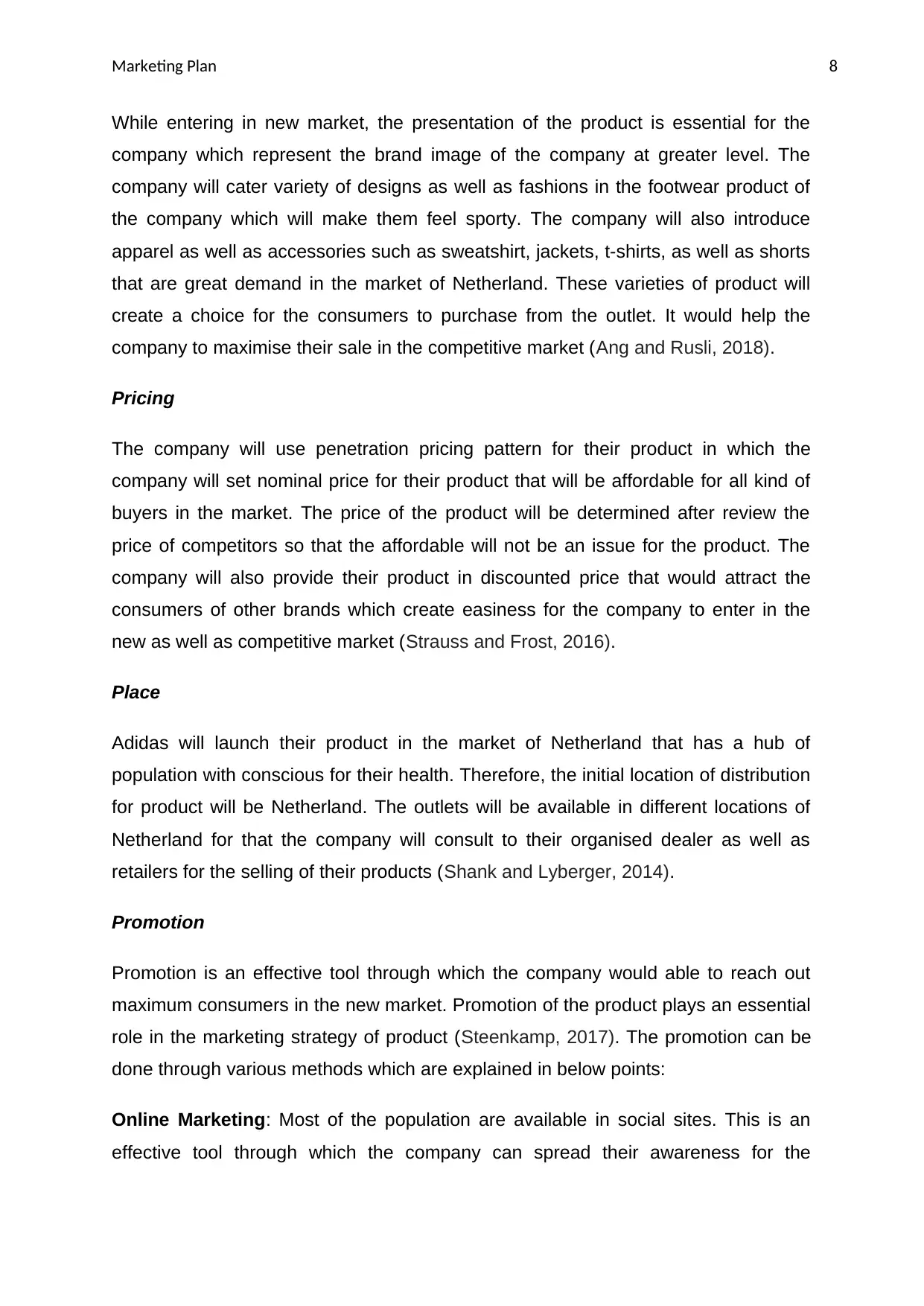
Marketing Plan 8
While entering in new market, the presentation of the product is essential for the
company which represent the brand image of the company at greater level. The
company will cater variety of designs as well as fashions in the footwear product of
the company which will make them feel sporty. The company will also introduce
apparel as well as accessories such as sweatshirt, jackets, t-shirts, as well as shorts
that are great demand in the market of Netherland. These varieties of product will
create a choice for the consumers to purchase from the outlet. It would help the
company to maximise their sale in the competitive market (Ang and Rusli, 2018).
Pricing
The company will use penetration pricing pattern for their product in which the
company will set nominal price for their product that will be affordable for all kind of
buyers in the market. The price of the product will be determined after review the
price of competitors so that the affordable will not be an issue for the product. The
company will also provide their product in discounted price that would attract the
consumers of other brands which create easiness for the company to enter in the
new as well as competitive market (Strauss and Frost, 2016).
Place
Adidas will launch their product in the market of Netherland that has a hub of
population with conscious for their health. Therefore, the initial location of distribution
for product will be Netherland. The outlets will be available in different locations of
Netherland for that the company will consult to their organised dealer as well as
retailers for the selling of their products (Shank and Lyberger, 2014).
Promotion
Promotion is an effective tool through which the company would able to reach out
maximum consumers in the new market. Promotion of the product plays an essential
role in the marketing strategy of product (Steenkamp, 2017). The promotion can be
done through various methods which are explained in below points:
Online Marketing: Most of the population are available in social sites. This is an
effective tool through which the company can spread their awareness for the
While entering in new market, the presentation of the product is essential for the
company which represent the brand image of the company at greater level. The
company will cater variety of designs as well as fashions in the footwear product of
the company which will make them feel sporty. The company will also introduce
apparel as well as accessories such as sweatshirt, jackets, t-shirts, as well as shorts
that are great demand in the market of Netherland. These varieties of product will
create a choice for the consumers to purchase from the outlet. It would help the
company to maximise their sale in the competitive market (Ang and Rusli, 2018).
Pricing
The company will use penetration pricing pattern for their product in which the
company will set nominal price for their product that will be affordable for all kind of
buyers in the market. The price of the product will be determined after review the
price of competitors so that the affordable will not be an issue for the product. The
company will also provide their product in discounted price that would attract the
consumers of other brands which create easiness for the company to enter in the
new as well as competitive market (Strauss and Frost, 2016).
Place
Adidas will launch their product in the market of Netherland that has a hub of
population with conscious for their health. Therefore, the initial location of distribution
for product will be Netherland. The outlets will be available in different locations of
Netherland for that the company will consult to their organised dealer as well as
retailers for the selling of their products (Shank and Lyberger, 2014).
Promotion
Promotion is an effective tool through which the company would able to reach out
maximum consumers in the new market. Promotion of the product plays an essential
role in the marketing strategy of product (Steenkamp, 2017). The promotion can be
done through various methods which are explained in below points:
Online Marketing: Most of the population are available in social sites. This is an
effective tool through which the company can spread their awareness for the
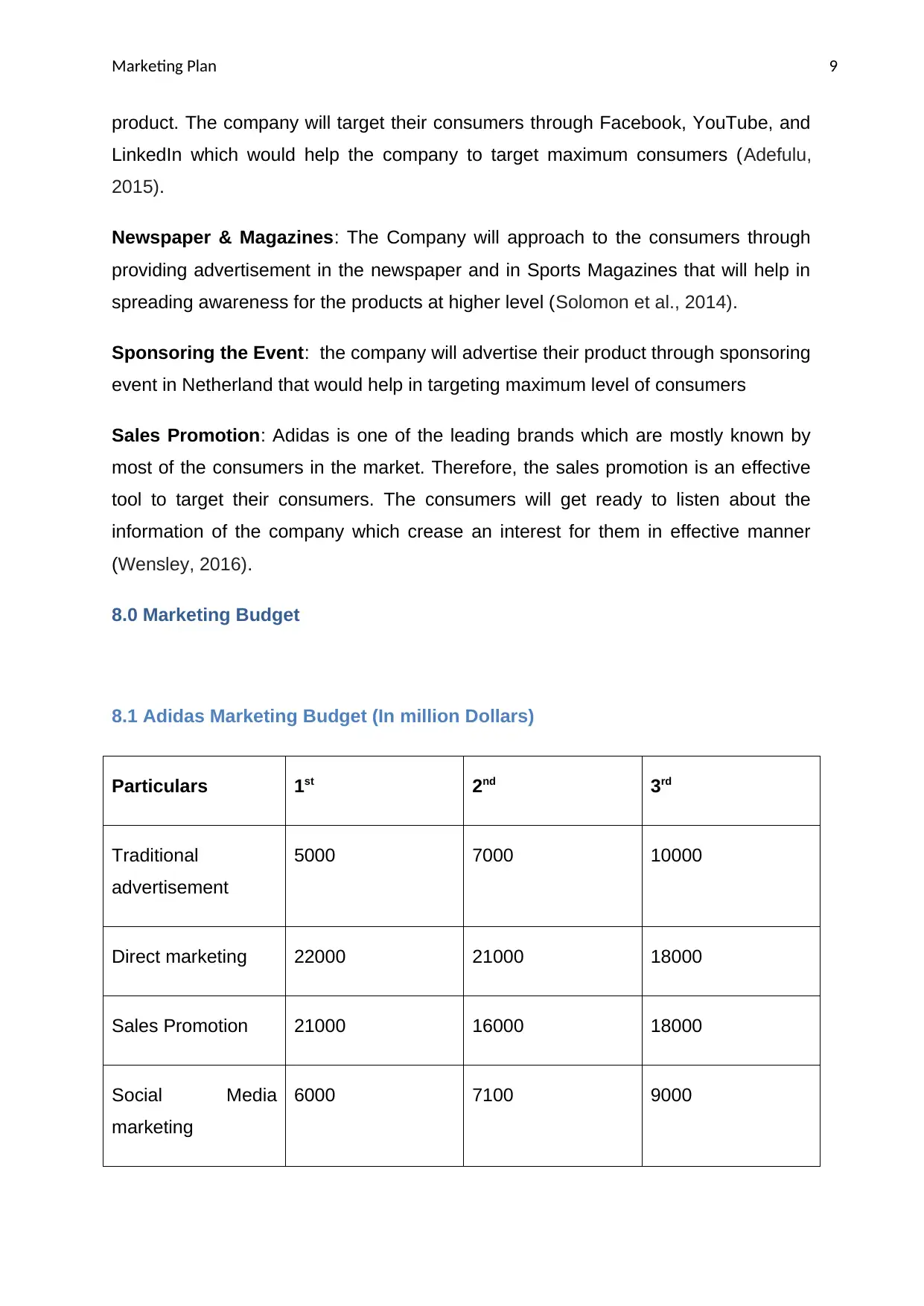
Marketing Plan 9
product. The company will target their consumers through Facebook, YouTube, and
LinkedIn which would help the company to target maximum consumers (Adefulu,
2015).
Newspaper & Magazines: The Company will approach to the consumers through
providing advertisement in the newspaper and in Sports Magazines that will help in
spreading awareness for the products at higher level (Solomon et al., 2014).
Sponsoring the Event: the company will advertise their product through sponsoring
event in Netherland that would help in targeting maximum level of consumers
Sales Promotion: Adidas is one of the leading brands which are mostly known by
most of the consumers in the market. Therefore, the sales promotion is an effective
tool to target their consumers. The consumers will get ready to listen about the
information of the company which crease an interest for them in effective manner
(Wensley, 2016).
8.0 Marketing Budget
8.1 Adidas Marketing Budget (In million Dollars)
Particulars 1st 2nd 3rd
Traditional
advertisement
5000 7000 10000
Direct marketing 22000 21000 18000
Sales Promotion 21000 16000 18000
Social Media
marketing
6000 7100 9000
product. The company will target their consumers through Facebook, YouTube, and
LinkedIn which would help the company to target maximum consumers (Adefulu,
2015).
Newspaper & Magazines: The Company will approach to the consumers through
providing advertisement in the newspaper and in Sports Magazines that will help in
spreading awareness for the products at higher level (Solomon et al., 2014).
Sponsoring the Event: the company will advertise their product through sponsoring
event in Netherland that would help in targeting maximum level of consumers
Sales Promotion: Adidas is one of the leading brands which are mostly known by
most of the consumers in the market. Therefore, the sales promotion is an effective
tool to target their consumers. The consumers will get ready to listen about the
information of the company which crease an interest for them in effective manner
(Wensley, 2016).
8.0 Marketing Budget
8.1 Adidas Marketing Budget (In million Dollars)
Particulars 1st 2nd 3rd
Traditional
advertisement
5000 7000 10000
Direct marketing 22000 21000 18000
Sales Promotion 21000 16000 18000
Social Media
marketing
6000 7100 9000
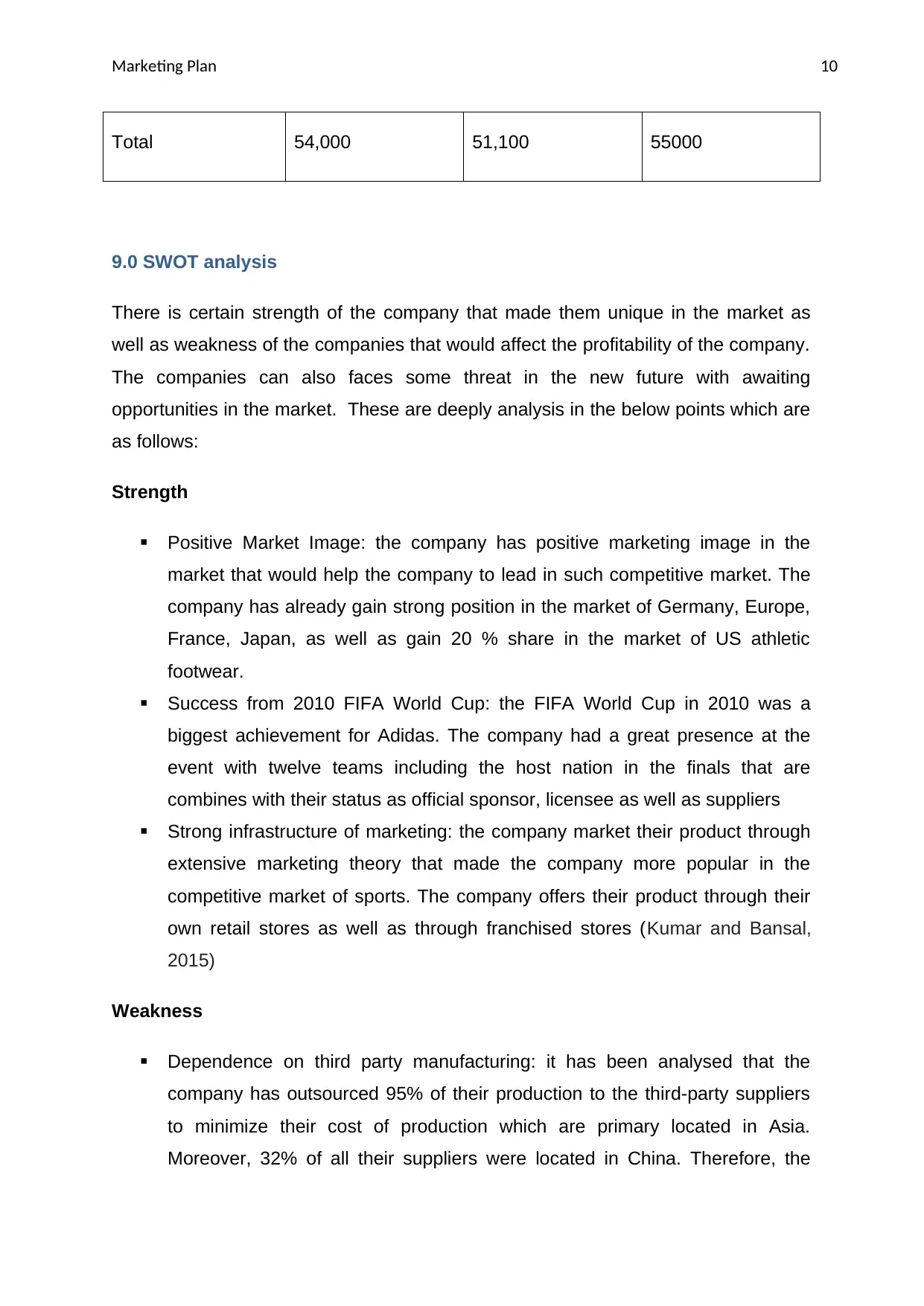
Marketing Plan 10
Total 54,000 51,100 55000
9.0 SWOT analysis
There is certain strength of the company that made them unique in the market as
well as weakness of the companies that would affect the profitability of the company.
The companies can also faces some threat in the new future with awaiting
opportunities in the market. These are deeply analysis in the below points which are
as follows:
Strength
Positive Market Image: the company has positive marketing image in the
market that would help the company to lead in such competitive market. The
company has already gain strong position in the market of Germany, Europe,
France, Japan, as well as gain 20 % share in the market of US athletic
footwear.
Success from 2010 FIFA World Cup: the FIFA World Cup in 2010 was a
biggest achievement for Adidas. The company had a great presence at the
event with twelve teams including the host nation in the finals that are
combines with their status as official sponsor, licensee as well as suppliers
Strong infrastructure of marketing: the company market their product through
extensive marketing theory that made the company more popular in the
competitive market of sports. The company offers their product through their
own retail stores as well as through franchised stores (Kumar and Bansal,
2015)
Weakness
Dependence on third party manufacturing: it has been analysed that the
company has outsourced 95% of their production to the third-party suppliers
to minimize their cost of production which are primary located in Asia.
Moreover, 32% of all their suppliers were located in China. Therefore, the
Total 54,000 51,100 55000
9.0 SWOT analysis
There is certain strength of the company that made them unique in the market as
well as weakness of the companies that would affect the profitability of the company.
The companies can also faces some threat in the new future with awaiting
opportunities in the market. These are deeply analysis in the below points which are
as follows:
Strength
Positive Market Image: the company has positive marketing image in the
market that would help the company to lead in such competitive market. The
company has already gain strong position in the market of Germany, Europe,
France, Japan, as well as gain 20 % share in the market of US athletic
footwear.
Success from 2010 FIFA World Cup: the FIFA World Cup in 2010 was a
biggest achievement for Adidas. The company had a great presence at the
event with twelve teams including the host nation in the finals that are
combines with their status as official sponsor, licensee as well as suppliers
Strong infrastructure of marketing: the company market their product through
extensive marketing theory that made the company more popular in the
competitive market of sports. The company offers their product through their
own retail stores as well as through franchised stores (Kumar and Bansal,
2015)
Weakness
Dependence on third party manufacturing: it has been analysed that the
company has outsourced 95% of their production to the third-party suppliers
to minimize their cost of production which are primary located in Asia.
Moreover, 32% of all their suppliers were located in China. Therefore, the
Secure Best Marks with AI Grader
Need help grading? Try our AI Grader for instant feedback on your assignments.
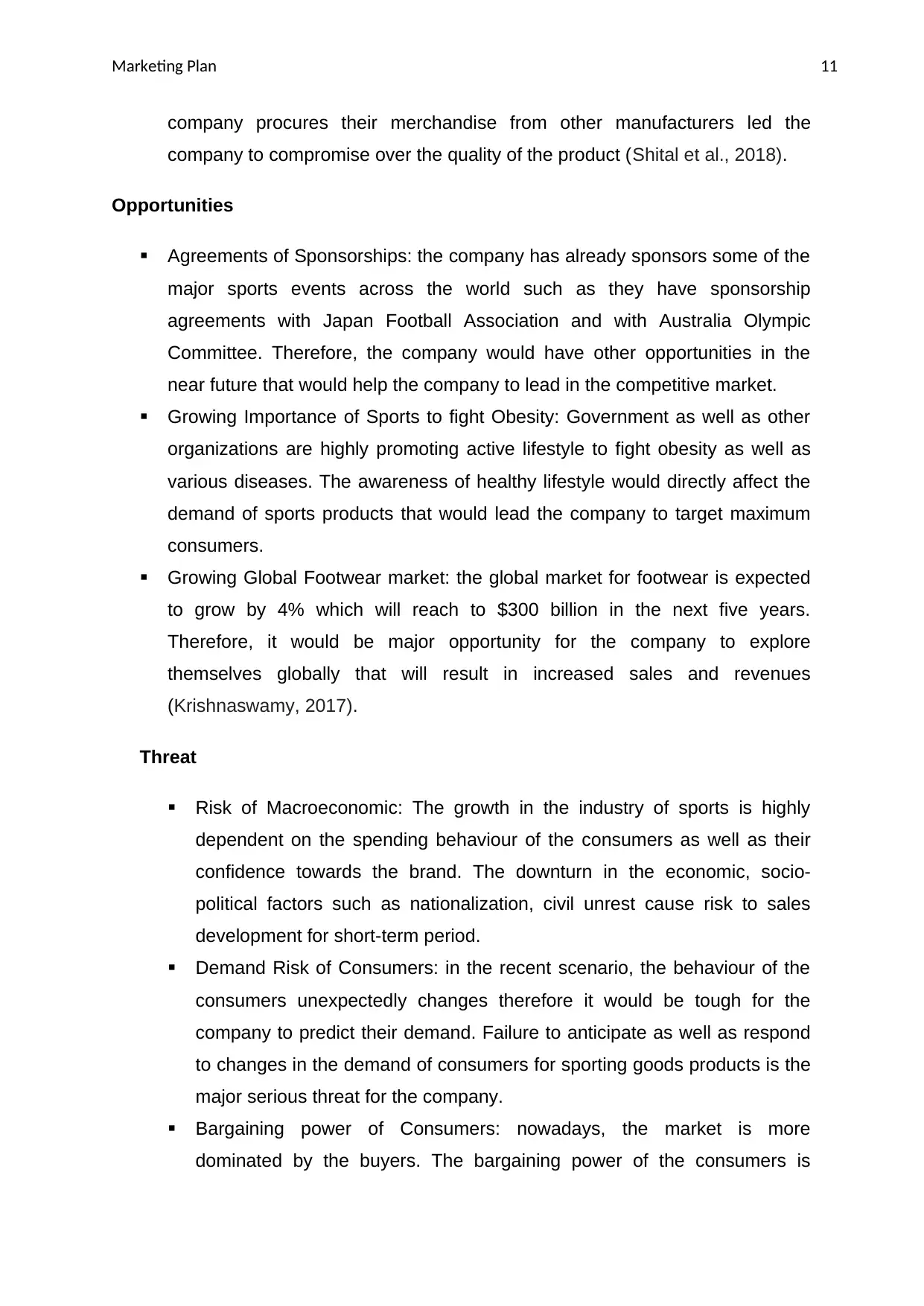
Marketing Plan 11
company procures their merchandise from other manufacturers led the
company to compromise over the quality of the product (Shital et al., 2018).
Opportunities
Agreements of Sponsorships: the company has already sponsors some of the
major sports events across the world such as they have sponsorship
agreements with Japan Football Association and with Australia Olympic
Committee. Therefore, the company would have other opportunities in the
near future that would help the company to lead in the competitive market.
Growing Importance of Sports to fight Obesity: Government as well as other
organizations are highly promoting active lifestyle to fight obesity as well as
various diseases. The awareness of healthy lifestyle would directly affect the
demand of sports products that would lead the company to target maximum
consumers.
Growing Global Footwear market: the global market for footwear is expected
to grow by 4% which will reach to $300 billion in the next five years.
Therefore, it would be major opportunity for the company to explore
themselves globally that will result in increased sales and revenues
(Krishnaswamy, 2017).
Threat
Risk of Macroeconomic: The growth in the industry of sports is highly
dependent on the spending behaviour of the consumers as well as their
confidence towards the brand. The downturn in the economic, socio-
political factors such as nationalization, civil unrest cause risk to sales
development for short-term period.
Demand Risk of Consumers: in the recent scenario, the behaviour of the
consumers unexpectedly changes therefore it would be tough for the
company to predict their demand. Failure to anticipate as well as respond
to changes in the demand of consumers for sporting goods products is the
major serious threat for the company.
Bargaining power of Consumers: nowadays, the market is more
dominated by the buyers. The bargaining power of the consumers is
company procures their merchandise from other manufacturers led the
company to compromise over the quality of the product (Shital et al., 2018).
Opportunities
Agreements of Sponsorships: the company has already sponsors some of the
major sports events across the world such as they have sponsorship
agreements with Japan Football Association and with Australia Olympic
Committee. Therefore, the company would have other opportunities in the
near future that would help the company to lead in the competitive market.
Growing Importance of Sports to fight Obesity: Government as well as other
organizations are highly promoting active lifestyle to fight obesity as well as
various diseases. The awareness of healthy lifestyle would directly affect the
demand of sports products that would lead the company to target maximum
consumers.
Growing Global Footwear market: the global market for footwear is expected
to grow by 4% which will reach to $300 billion in the next five years.
Therefore, it would be major opportunity for the company to explore
themselves globally that will result in increased sales and revenues
(Krishnaswamy, 2017).
Threat
Risk of Macroeconomic: The growth in the industry of sports is highly
dependent on the spending behaviour of the consumers as well as their
confidence towards the brand. The downturn in the economic, socio-
political factors such as nationalization, civil unrest cause risk to sales
development for short-term period.
Demand Risk of Consumers: in the recent scenario, the behaviour of the
consumers unexpectedly changes therefore it would be tough for the
company to predict their demand. Failure to anticipate as well as respond
to changes in the demand of consumers for sporting goods products is the
major serious threat for the company.
Bargaining power of Consumers: nowadays, the market is more
dominated by the buyers. The bargaining power of the consumers is
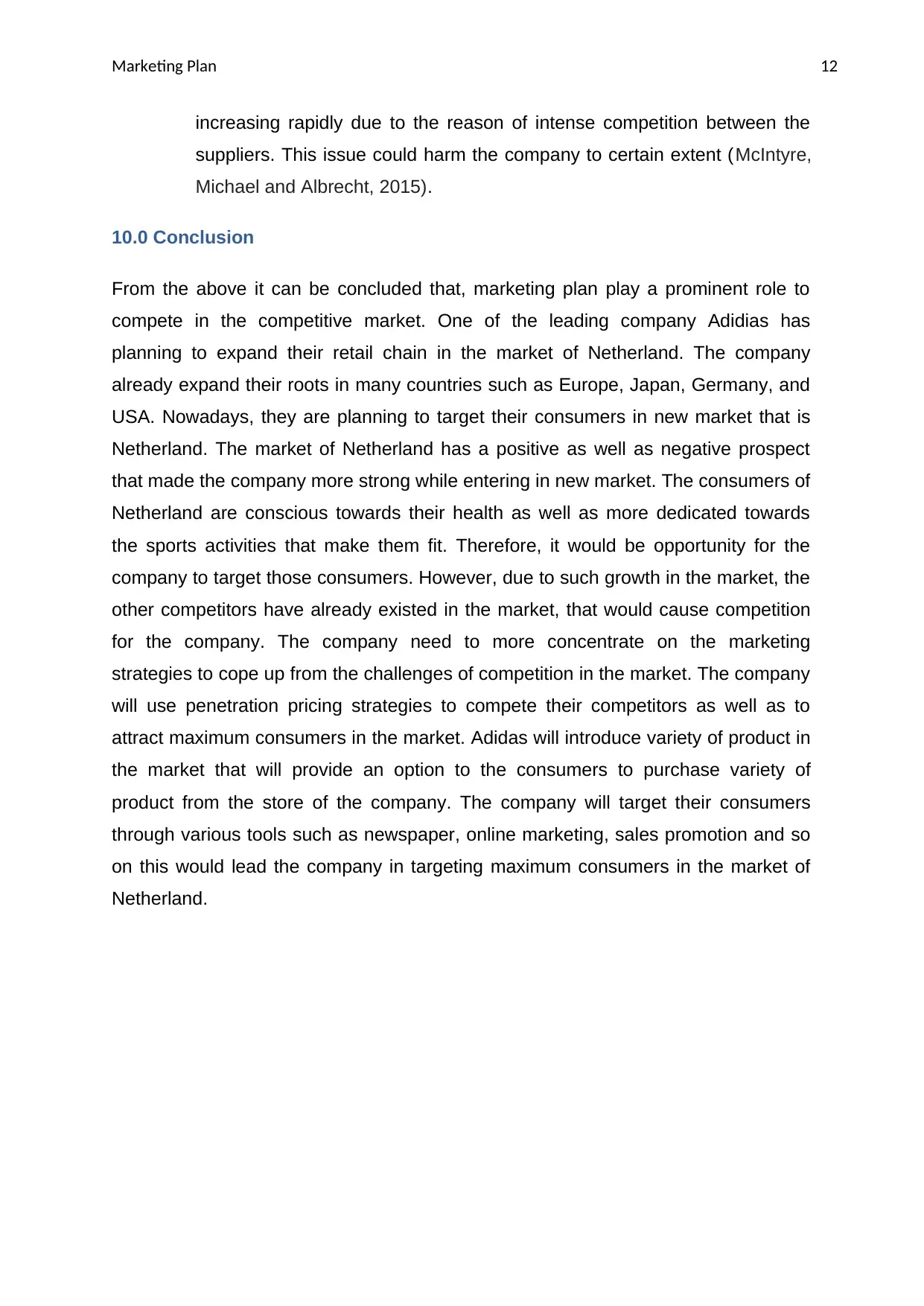
Marketing Plan 12
increasing rapidly due to the reason of intense competition between the
suppliers. This issue could harm the company to certain extent (McIntyre,
Michael and Albrecht, 2015).
10.0 Conclusion
From the above it can be concluded that, marketing plan play a prominent role to
compete in the competitive market. One of the leading company Adidias has
planning to expand their retail chain in the market of Netherland. The company
already expand their roots in many countries such as Europe, Japan, Germany, and
USA. Nowadays, they are planning to target their consumers in new market that is
Netherland. The market of Netherland has a positive as well as negative prospect
that made the company more strong while entering in new market. The consumers of
Netherland are conscious towards their health as well as more dedicated towards
the sports activities that make them fit. Therefore, it would be opportunity for the
company to target those consumers. However, due to such growth in the market, the
other competitors have already existed in the market, that would cause competition
for the company. The company need to more concentrate on the marketing
strategies to cope up from the challenges of competition in the market. The company
will use penetration pricing strategies to compete their competitors as well as to
attract maximum consumers in the market. Adidas will introduce variety of product in
the market that will provide an option to the consumers to purchase variety of
product from the store of the company. The company will target their consumers
through various tools such as newspaper, online marketing, sales promotion and so
on this would lead the company in targeting maximum consumers in the market of
Netherland.
increasing rapidly due to the reason of intense competition between the
suppliers. This issue could harm the company to certain extent (McIntyre,
Michael and Albrecht, 2015).
10.0 Conclusion
From the above it can be concluded that, marketing plan play a prominent role to
compete in the competitive market. One of the leading company Adidias has
planning to expand their retail chain in the market of Netherland. The company
already expand their roots in many countries such as Europe, Japan, Germany, and
USA. Nowadays, they are planning to target their consumers in new market that is
Netherland. The market of Netherland has a positive as well as negative prospect
that made the company more strong while entering in new market. The consumers of
Netherland are conscious towards their health as well as more dedicated towards
the sports activities that make them fit. Therefore, it would be opportunity for the
company to target those consumers. However, due to such growth in the market, the
other competitors have already existed in the market, that would cause competition
for the company. The company need to more concentrate on the marketing
strategies to cope up from the challenges of competition in the market. The company
will use penetration pricing strategies to compete their competitors as well as to
attract maximum consumers in the market. Adidas will introduce variety of product in
the market that will provide an option to the consumers to purchase variety of
product from the store of the company. The company will target their consumers
through various tools such as newspaper, online marketing, sales promotion and so
on this would lead the company in targeting maximum consumers in the market of
Netherland.
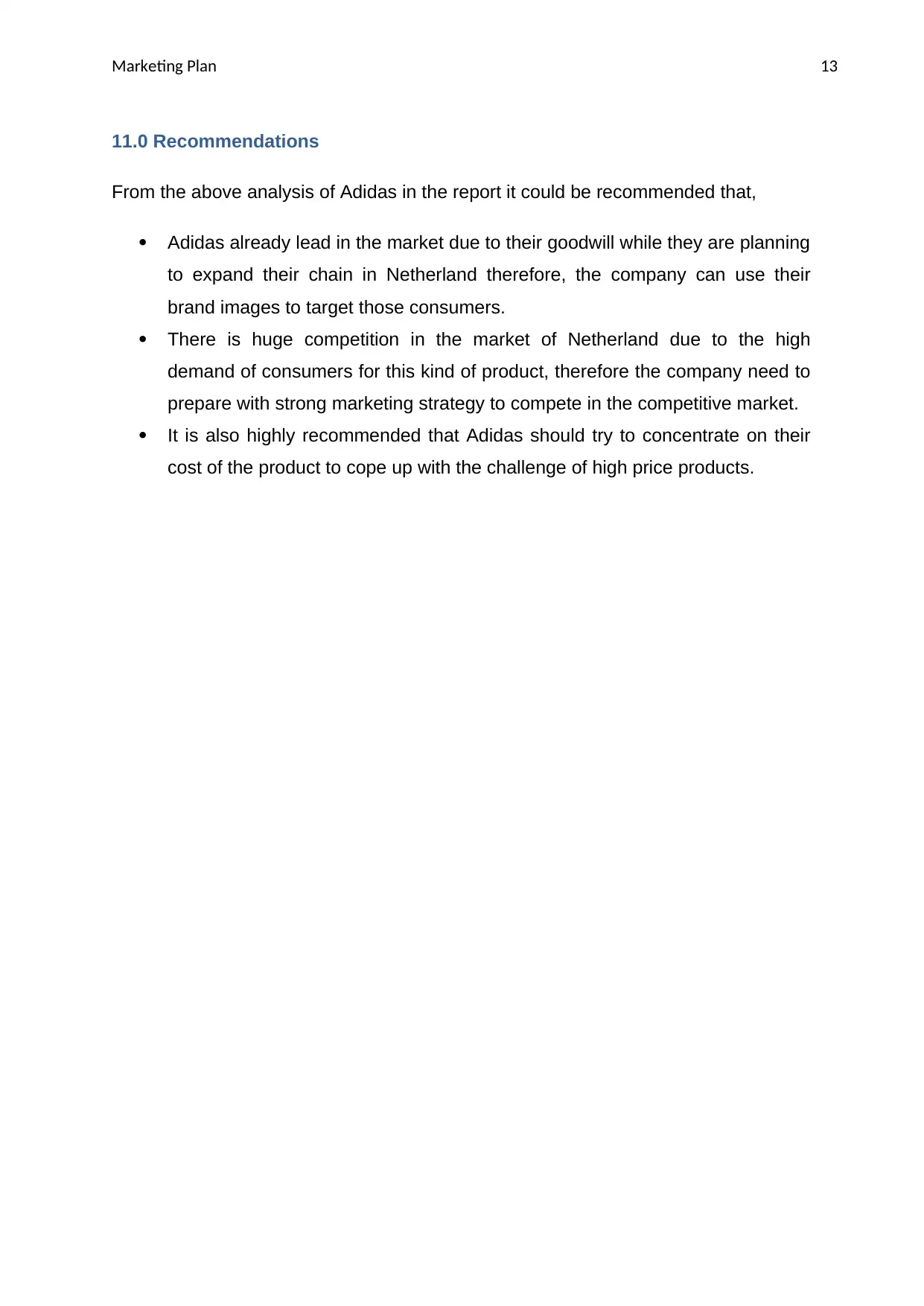
Marketing Plan 13
11.0 Recommendations
From the above analysis of Adidas in the report it could be recommended that,
Adidas already lead in the market due to their goodwill while they are planning
to expand their chain in Netherland therefore, the company can use their
brand images to target those consumers.
There is huge competition in the market of Netherland due to the high
demand of consumers for this kind of product, therefore the company need to
prepare with strong marketing strategy to compete in the competitive market.
It is also highly recommended that Adidas should try to concentrate on their
cost of the product to cope up with the challenge of high price products.
11.0 Recommendations
From the above analysis of Adidas in the report it could be recommended that,
Adidas already lead in the market due to their goodwill while they are planning
to expand their chain in Netherland therefore, the company can use their
brand images to target those consumers.
There is huge competition in the market of Netherland due to the high
demand of consumers for this kind of product, therefore the company need to
prepare with strong marketing strategy to compete in the competitive market.
It is also highly recommended that Adidas should try to concentrate on their
cost of the product to cope up with the challenge of high price products.
Paraphrase This Document
Need a fresh take? Get an instant paraphrase of this document with our AI Paraphraser
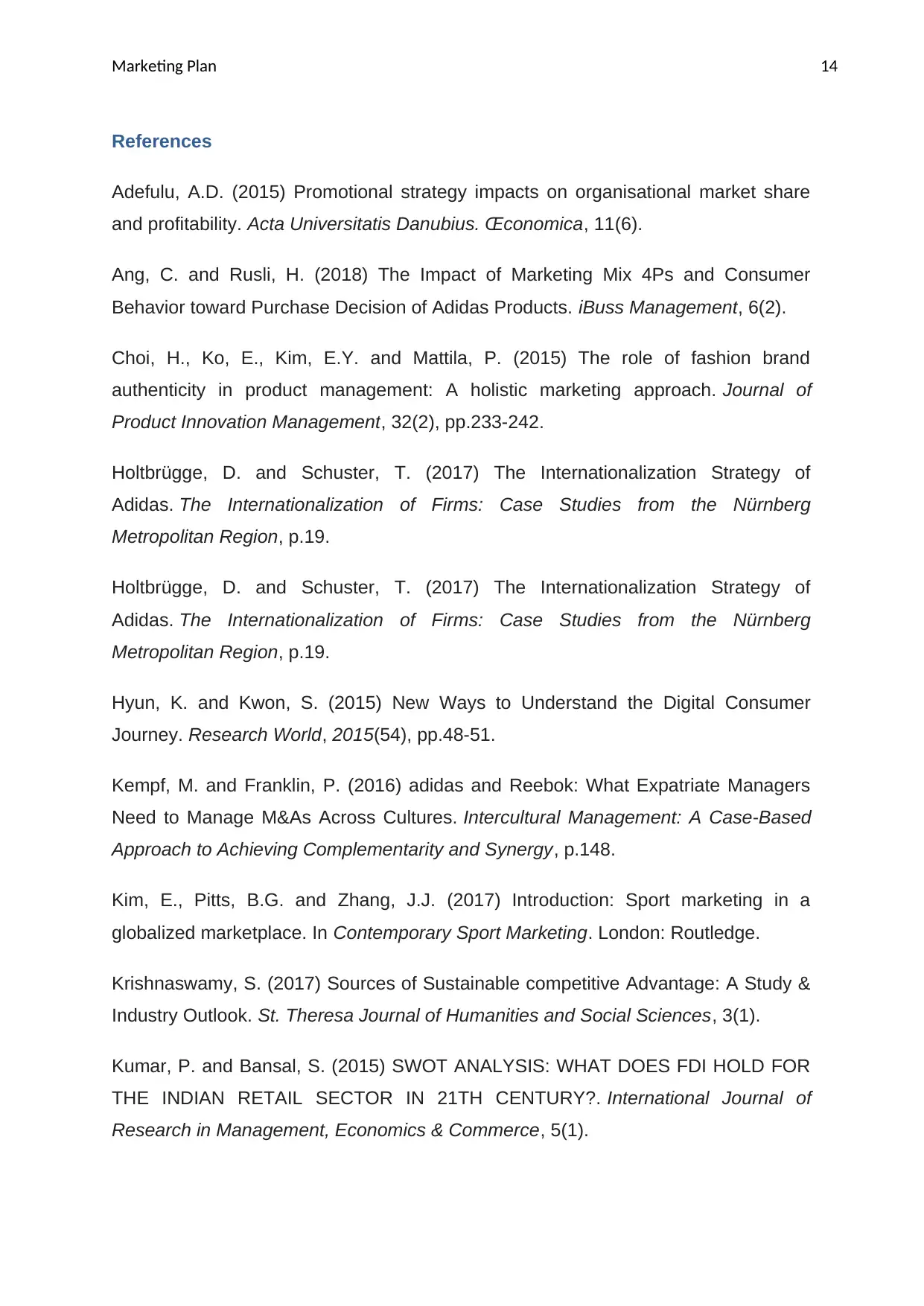
Marketing Plan 14
References
Adefulu, A.D. (2015) Promotional strategy impacts on organisational market share
and profitability. Acta Universitatis Danubius. Œconomica, 11(6).
Ang, C. and Rusli, H. (2018) The Impact of Marketing Mix 4Ps and Consumer
Behavior toward Purchase Decision of Adidas Products. iBuss Management, 6(2).
Choi, H., Ko, E., Kim, E.Y. and Mattila, P. (2015) The role of fashion brand
authenticity in product management: A holistic marketing approach. Journal of
Product Innovation Management, 32(2), pp.233-242.
Holtbrügge, D. and Schuster, T. (2017) The Internationalization Strategy of
Adidas. The Internationalization of Firms: Case Studies from the Nürnberg
Metropolitan Region, p.19.
Holtbrügge, D. and Schuster, T. (2017) The Internationalization Strategy of
Adidas. The Internationalization of Firms: Case Studies from the Nürnberg
Metropolitan Region, p.19.
Hyun, K. and Kwon, S. (2015) New Ways to Understand the Digital Consumer
Journey. Research World, 2015(54), pp.48-51.
Kempf, M. and Franklin, P. (2016) adidas and Reebok: What Expatriate Managers
Need to Manage M&As Across Cultures. Intercultural Management: A Case-Based
Approach to Achieving Complementarity and Synergy, p.148.
Kim, E., Pitts, B.G. and Zhang, J.J. (2017) Introduction: Sport marketing in a
globalized marketplace. In Contemporary Sport Marketing. London: Routledge.
Krishnaswamy, S. (2017) Sources of Sustainable competitive Advantage: A Study &
Industry Outlook. St. Theresa Journal of Humanities and Social Sciences, 3(1).
Kumar, P. and Bansal, S. (2015) SWOT ANALYSIS: WHAT DOES FDI HOLD FOR
THE INDIAN RETAIL SECTOR IN 21TH CENTURY?. International Journal of
Research in Management, Economics & Commerce, 5(1).
References
Adefulu, A.D. (2015) Promotional strategy impacts on organisational market share
and profitability. Acta Universitatis Danubius. Œconomica, 11(6).
Ang, C. and Rusli, H. (2018) The Impact of Marketing Mix 4Ps and Consumer
Behavior toward Purchase Decision of Adidas Products. iBuss Management, 6(2).
Choi, H., Ko, E., Kim, E.Y. and Mattila, P. (2015) The role of fashion brand
authenticity in product management: A holistic marketing approach. Journal of
Product Innovation Management, 32(2), pp.233-242.
Holtbrügge, D. and Schuster, T. (2017) The Internationalization Strategy of
Adidas. The Internationalization of Firms: Case Studies from the Nürnberg
Metropolitan Region, p.19.
Holtbrügge, D. and Schuster, T. (2017) The Internationalization Strategy of
Adidas. The Internationalization of Firms: Case Studies from the Nürnberg
Metropolitan Region, p.19.
Hyun, K. and Kwon, S. (2015) New Ways to Understand the Digital Consumer
Journey. Research World, 2015(54), pp.48-51.
Kempf, M. and Franklin, P. (2016) adidas and Reebok: What Expatriate Managers
Need to Manage M&As Across Cultures. Intercultural Management: A Case-Based
Approach to Achieving Complementarity and Synergy, p.148.
Kim, E., Pitts, B.G. and Zhang, J.J. (2017) Introduction: Sport marketing in a
globalized marketplace. In Contemporary Sport Marketing. London: Routledge.
Krishnaswamy, S. (2017) Sources of Sustainable competitive Advantage: A Study &
Industry Outlook. St. Theresa Journal of Humanities and Social Sciences, 3(1).
Kumar, P. and Bansal, S. (2015) SWOT ANALYSIS: WHAT DOES FDI HOLD FOR
THE INDIAN RETAIL SECTOR IN 21TH CENTURY?. International Journal of
Research in Management, Economics & Commerce, 5(1).
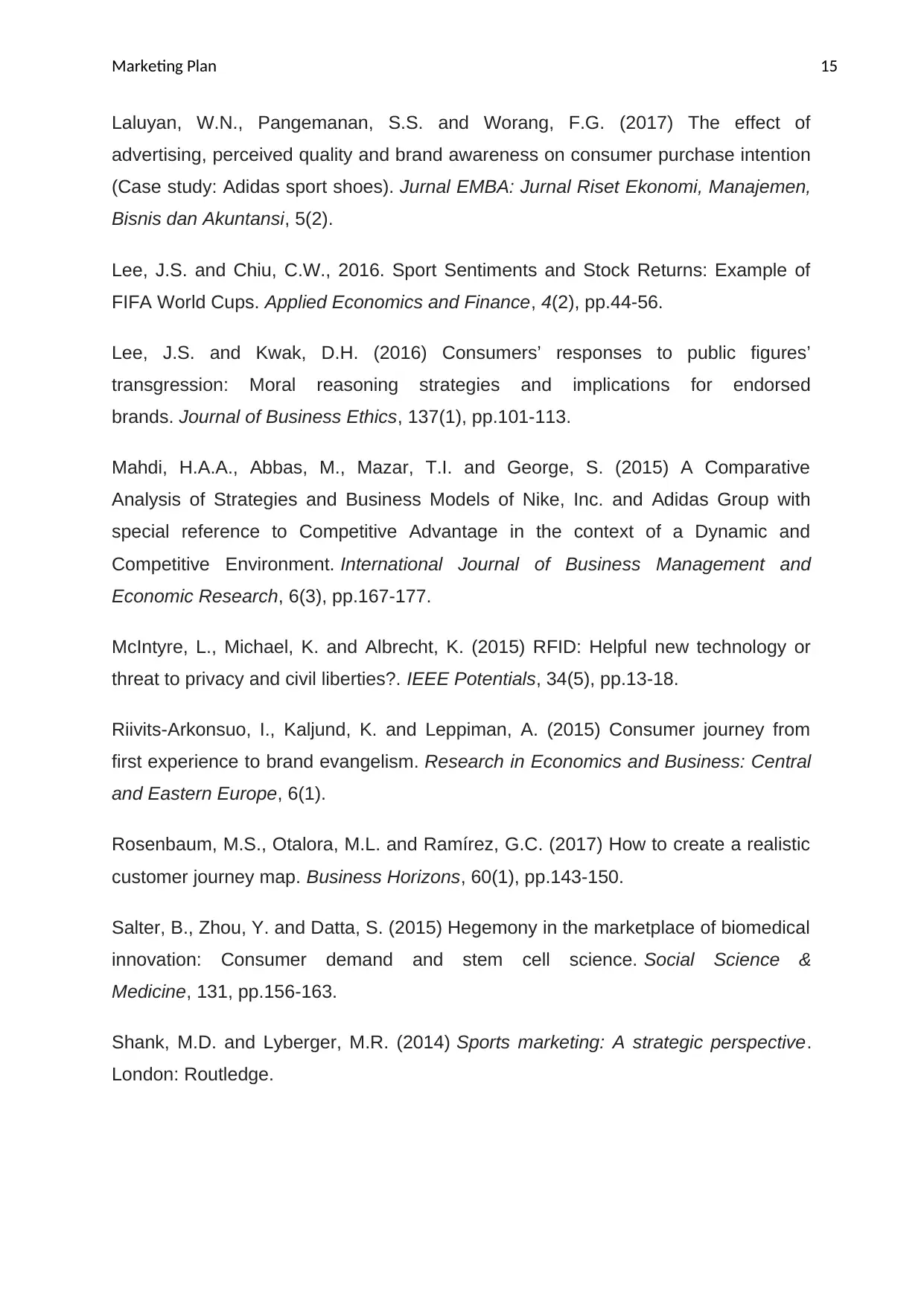
Marketing Plan 15
Laluyan, W.N., Pangemanan, S.S. and Worang, F.G. (2017) The effect of
advertising, perceived quality and brand awareness on consumer purchase intention
(Case study: Adidas sport shoes). Jurnal EMBA: Jurnal Riset Ekonomi, Manajemen,
Bisnis dan Akuntansi, 5(2).
Lee, J.S. and Chiu, C.W., 2016. Sport Sentiments and Stock Returns: Example of
FIFA World Cups. Applied Economics and Finance, 4(2), pp.44-56.
Lee, J.S. and Kwak, D.H. (2016) Consumers’ responses to public figures’
transgression: Moral reasoning strategies and implications for endorsed
brands. Journal of Business Ethics, 137(1), pp.101-113.
Mahdi, H.A.A., Abbas, M., Mazar, T.I. and George, S. (2015) A Comparative
Analysis of Strategies and Business Models of Nike, Inc. and Adidas Group with
special reference to Competitive Advantage in the context of a Dynamic and
Competitive Environment. International Journal of Business Management and
Economic Research, 6(3), pp.167-177.
McIntyre, L., Michael, K. and Albrecht, K. (2015) RFID: Helpful new technology or
threat to privacy and civil liberties?. IEEE Potentials, 34(5), pp.13-18.
Riivits-Arkonsuo, I., Kaljund, K. and Leppiman, A. (2015) Consumer journey from
first experience to brand evangelism. Research in Economics and Business: Central
and Eastern Europe, 6(1).
Rosenbaum, M.S., Otalora, M.L. and Ramírez, G.C. (2017) How to create a realistic
customer journey map. Business Horizons, 60(1), pp.143-150.
Salter, B., Zhou, Y. and Datta, S. (2015) Hegemony in the marketplace of biomedical
innovation: Consumer demand and stem cell science. Social Science &
Medicine, 131, pp.156-163.
Shank, M.D. and Lyberger, M.R. (2014) Sports marketing: A strategic perspective.
London: Routledge.
Laluyan, W.N., Pangemanan, S.S. and Worang, F.G. (2017) The effect of
advertising, perceived quality and brand awareness on consumer purchase intention
(Case study: Adidas sport shoes). Jurnal EMBA: Jurnal Riset Ekonomi, Manajemen,
Bisnis dan Akuntansi, 5(2).
Lee, J.S. and Chiu, C.W., 2016. Sport Sentiments and Stock Returns: Example of
FIFA World Cups. Applied Economics and Finance, 4(2), pp.44-56.
Lee, J.S. and Kwak, D.H. (2016) Consumers’ responses to public figures’
transgression: Moral reasoning strategies and implications for endorsed
brands. Journal of Business Ethics, 137(1), pp.101-113.
Mahdi, H.A.A., Abbas, M., Mazar, T.I. and George, S. (2015) A Comparative
Analysis of Strategies and Business Models of Nike, Inc. and Adidas Group with
special reference to Competitive Advantage in the context of a Dynamic and
Competitive Environment. International Journal of Business Management and
Economic Research, 6(3), pp.167-177.
McIntyre, L., Michael, K. and Albrecht, K. (2015) RFID: Helpful new technology or
threat to privacy and civil liberties?. IEEE Potentials, 34(5), pp.13-18.
Riivits-Arkonsuo, I., Kaljund, K. and Leppiman, A. (2015) Consumer journey from
first experience to brand evangelism. Research in Economics and Business: Central
and Eastern Europe, 6(1).
Rosenbaum, M.S., Otalora, M.L. and Ramírez, G.C. (2017) How to create a realistic
customer journey map. Business Horizons, 60(1), pp.143-150.
Salter, B., Zhou, Y. and Datta, S. (2015) Hegemony in the marketplace of biomedical
innovation: Consumer demand and stem cell science. Social Science &
Medicine, 131, pp.156-163.
Shank, M.D. and Lyberger, M.R. (2014) Sports marketing: A strategic perspective.
London: Routledge.
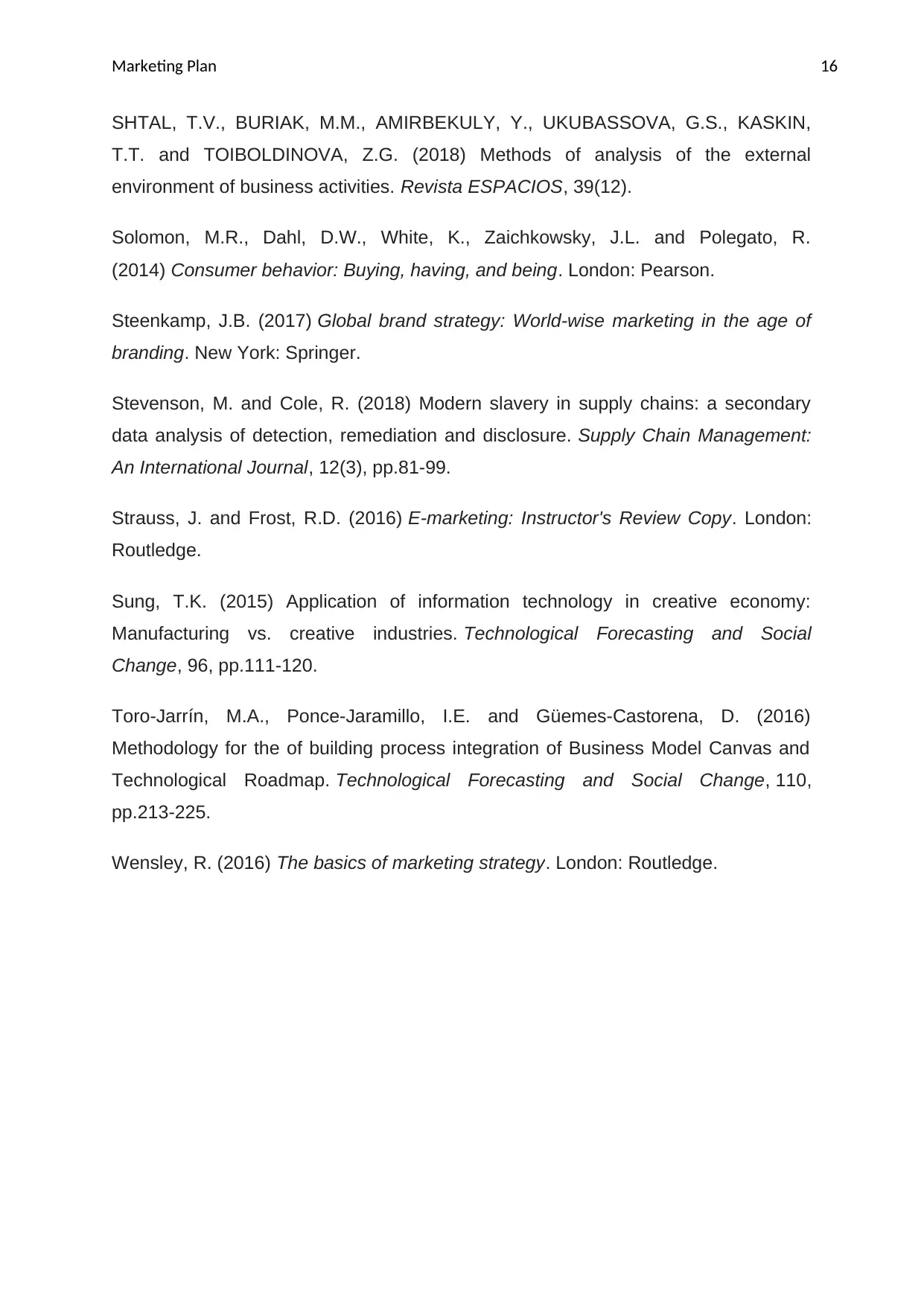
Marketing Plan 16
SHTAL, T.V., BURIAK, M.M., AMIRBEKULY, Y., UKUBASSOVA, G.S., KASKIN,
T.T. and TOIBOLDINOVA, Z.G. (2018) Methods of analysis of the external
environment of business activities. Revista ESPACIOS, 39(12).
Solomon, M.R., Dahl, D.W., White, K., Zaichkowsky, J.L. and Polegato, R.
(2014) Consumer behavior: Buying, having, and being. London: Pearson.
Steenkamp, J.B. (2017) Global brand strategy: World-wise marketing in the age of
branding. New York: Springer.
Stevenson, M. and Cole, R. (2018) Modern slavery in supply chains: a secondary
data analysis of detection, remediation and disclosure. Supply Chain Management:
An International Journal, 12(3), pp.81-99.
Strauss, J. and Frost, R.D. (2016) E-marketing: Instructor's Review Copy. London:
Routledge.
Sung, T.K. (2015) Application of information technology in creative economy:
Manufacturing vs. creative industries. Technological Forecasting and Social
Change, 96, pp.111-120.
Toro-Jarrín, M.A., Ponce-Jaramillo, I.E. and Güemes-Castorena, D. (2016)
Methodology for the of building process integration of Business Model Canvas and
Technological Roadmap. Technological Forecasting and Social Change, 110,
pp.213-225.
Wensley, R. (2016) The basics of marketing strategy. London: Routledge.
SHTAL, T.V., BURIAK, M.M., AMIRBEKULY, Y., UKUBASSOVA, G.S., KASKIN,
T.T. and TOIBOLDINOVA, Z.G. (2018) Methods of analysis of the external
environment of business activities. Revista ESPACIOS, 39(12).
Solomon, M.R., Dahl, D.W., White, K., Zaichkowsky, J.L. and Polegato, R.
(2014) Consumer behavior: Buying, having, and being. London: Pearson.
Steenkamp, J.B. (2017) Global brand strategy: World-wise marketing in the age of
branding. New York: Springer.
Stevenson, M. and Cole, R. (2018) Modern slavery in supply chains: a secondary
data analysis of detection, remediation and disclosure. Supply Chain Management:
An International Journal, 12(3), pp.81-99.
Strauss, J. and Frost, R.D. (2016) E-marketing: Instructor's Review Copy. London:
Routledge.
Sung, T.K. (2015) Application of information technology in creative economy:
Manufacturing vs. creative industries. Technological Forecasting and Social
Change, 96, pp.111-120.
Toro-Jarrín, M.A., Ponce-Jaramillo, I.E. and Güemes-Castorena, D. (2016)
Methodology for the of building process integration of Business Model Canvas and
Technological Roadmap. Technological Forecasting and Social Change, 110,
pp.213-225.
Wensley, R. (2016) The basics of marketing strategy. London: Routledge.
1 out of 16
Related Documents
Your All-in-One AI-Powered Toolkit for Academic Success.
+13062052269
info@desklib.com
Available 24*7 on WhatsApp / Email
![[object Object]](/_next/static/media/star-bottom.7253800d.svg)
Unlock your academic potential
© 2024 | Zucol Services PVT LTD | All rights reserved.





